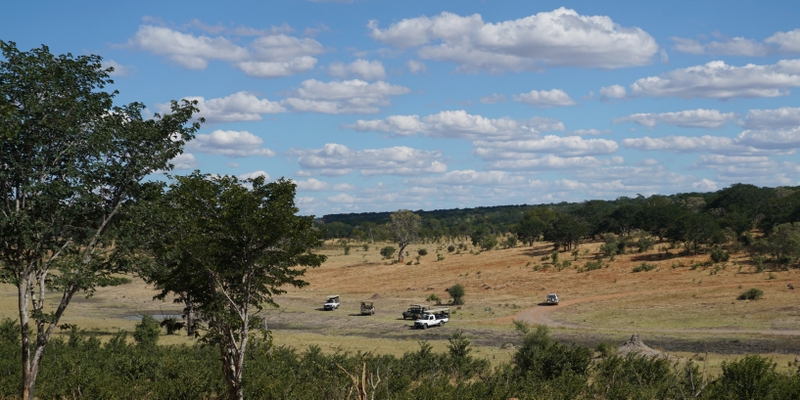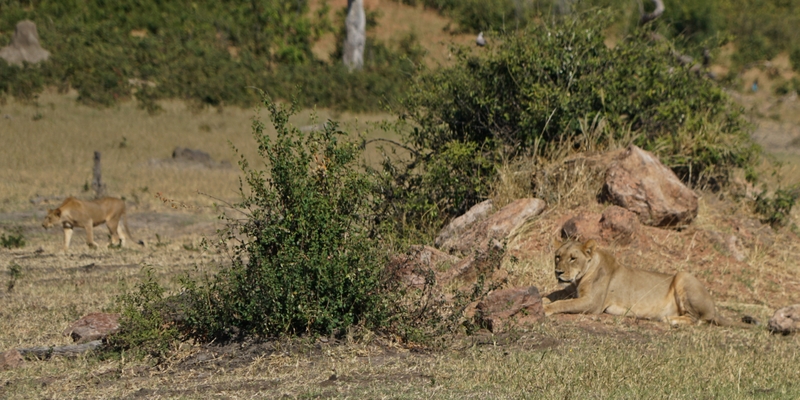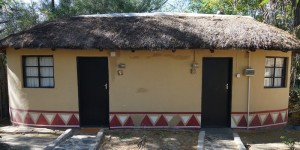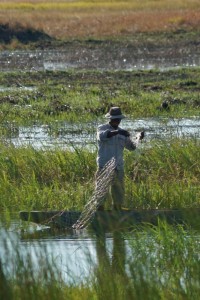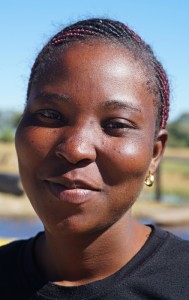 |
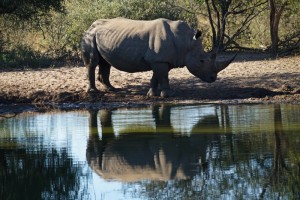 |
Botswana with its world famous Okavango Delta and wildlife, has become a popular destination in Africa. I join a 7-day organised tour from Victoria Falls to Johannesburg spending six full days in Botswana visiting the Chobe National Park, Okavango Delta and Khama Rhino Sanctuary.Botswana a landlocked country with an area of 581,730km², is one of the most sparsely populated nations in the world with a population of 2 million. The country is topographically flat with up to 70% of its territory being the Kalahari Desert. It was a British protectorate of Bechuanaland since 1885 while the southern territory became part of the Cape Colonyremained under direct administration till it gained its independence in September 1966.
With the discovery of diamond in 1967 and as a result of stable representative democracy, it has transformed itself into being one of the poorest countries in the world with a GDP per capita of about US$70 a year in late 1960s to one of the highest in Africa at over $18,000 in 2015. The country’s currency is Bostwana pula. It boasts two World Heritage Sites namely Tsodilo (with rock paintings) and the Okavango Delta.
Tswana is the major ethnic group in Botswana comprising 79% of the population. Two other major ethnic groups are the Kalanga (11%) and Basarwa, Kgalagadi and White (each 3%). HIV/AIDS epidemic is a serious problem with around a quarter of the population estimated to be infected.
Why Botswana?
I would like to visit a new country in Southern Africa after my 20-day Cape Town to Johannesburg tour. As I have already been to Namibia, Botswana is a natural choice especially the country has an exemplary record in wildlife conservation and political stability. After some research, I booked a 7 Day Okavango Delta Budget Lodge Safari which fits in my travel dates. I flew from Johannesburg to Victoria Falls on May 26 and had an enjoyable day in Zambia on May 27.
May 28 Saturday: Victoria Falls, Zimbabwe – Chobe National Park, Botswana (90km)
I have picked a small group tour with accommodation (not camping) organised by Acacia Travel. I woke up early and walked with my suitcase from Shoestrings Hostel to Cresta Hotel to meet up with the group. Around 8am, I met the group leader cum driver Simon, a Zimbabwean and 11 passengers when the bus set off at 8:30pm. It’s a predominant American group with eight passengers from the US (a family of four – Judy, Gary, Victory and Pretty), Dru and her daughter Becky, Alan and Ken. Natalie and Tian come from New Zealand while Andrea is an Italian tour consultant specialised in wildlife.
Victory Falls is close to the border and we entered Botswana without hassle. Simon dropped us in Kansane around 10:30am so that we could change money, have lunch and stock up with drinks and snacks. I got about 10 pula for a dollar. Today, we had the busiest as well as the best day of the whole tour. As soon as we arrived at the Thebe Safari Lodge, Simon arranged us to join a 4×4 game drive at Chobe National Park for 350 pula.
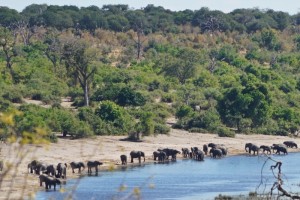 Chobe National Park located in northern Botswana has one of the largest concentrations of game in Africa. It is Botswana’s first national park and the most biologically diverse national park. By size, it is the third largest after the Central Kalahari Game Reserve and the Gemsbok National Park. It can be divided into four areas each corresponding to one distinct ecosystem. The Chobe riverfront situated in the extreme northeast of the park has lush floodplains and dense woodland of mahogany, teak and other hardwoods. The Chobe River is a major watering spot for animals and birds. It is the most visited section of the park. The Savuti Marsh area constitutes the western stretch of the park and is a good spot for viewing the annual migration of zebras and predators. The Linyanti Marsh located at the northwest corner of the park and adjacent to Linyanti River has large concentrations of lion, leopard, African wild dog, roan and sable antelope, hippo and enormous herds of elephants. Bird life is very rich too. Between Linyanti and Savuti Marshes lies a hot and dry hinterland mainly occupied by the Nogatsaa grass woodland.
Chobe National Park located in northern Botswana has one of the largest concentrations of game in Africa. It is Botswana’s first national park and the most biologically diverse national park. By size, it is the third largest after the Central Kalahari Game Reserve and the Gemsbok National Park. It can be divided into four areas each corresponding to one distinct ecosystem. The Chobe riverfront situated in the extreme northeast of the park has lush floodplains and dense woodland of mahogany, teak and other hardwoods. The Chobe River is a major watering spot for animals and birds. It is the most visited section of the park. The Savuti Marsh area constitutes the western stretch of the park and is a good spot for viewing the annual migration of zebras and predators. The Linyanti Marsh located at the northwest corner of the park and adjacent to Linyanti River has large concentrations of lion, leopard, African wild dog, roan and sable antelope, hippo and enormous herds of elephants. Bird life is very rich too. Between Linyanti and Savuti Marshes lies a hot and dry hinterland mainly occupied by the Nogatsaa grass woodland.
By 12 noon, we were off accompanied by a knowledgeable local guide. The park is widely known for its Kalahari Elephant population which is estimated to be around 50,000 (built up from a few thousand since 1990). We saw plenty of elephants (30-50) on the way to the entrance of the Park. During the game drive, we saw more and more elephants and many impala. Then our guide spotted a lion sleeping under a tree. We got very close without disturbing it from its afternoon nap.
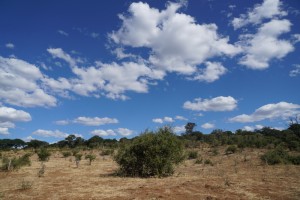 |
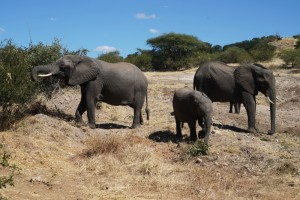 |
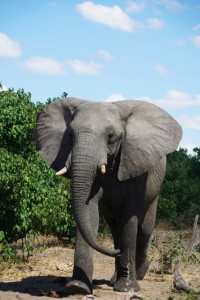 |
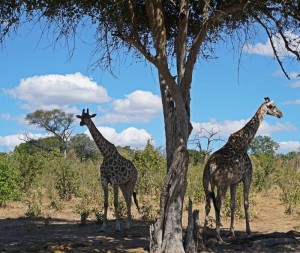 |
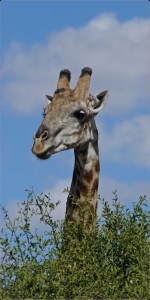 |
Then we saw a few vehicles stopped by the road side nearby. We went over and saw two female lionesses stalking three warthogs by a watering hole. Soon a third lioness arrived. Unfortunately, the warthogs sensed danger and moved away. We watched this scene for over 20 minutes.
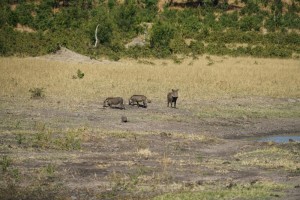 |
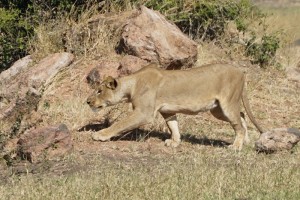 |
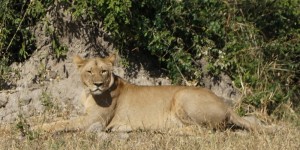 |
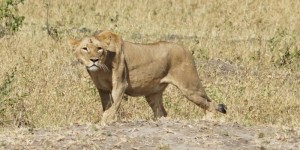 |
Shortly after 3pm, we headed to the Chobe River for a sunset cruise. The border along the main channel of the River up to Zambezi was disputed with Nambia until a ruling in 1999 by the International Court of Justice which flavoured Botswana. I had the best sunset cruise: numerous elephants were feeding in the river and hippos submerged in the water with their ears flickering from time to time. We spotted many birds, crocodiles, lizards and monkeys along the river.
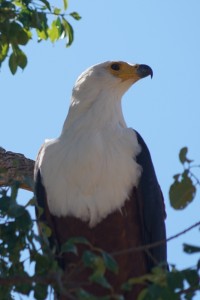 |
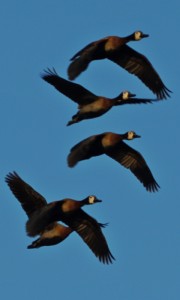 |
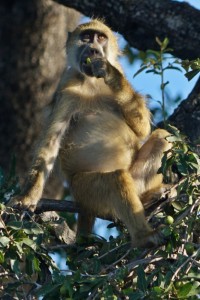 |
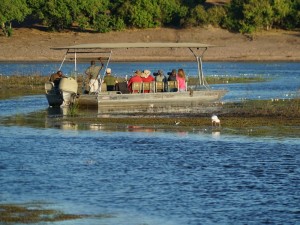 |
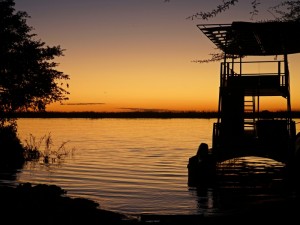 |
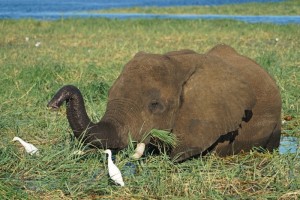 |
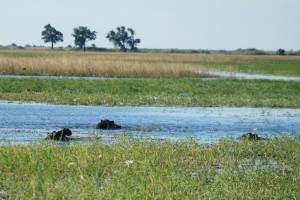 |
May 29 Sunday: Chobe National Park – Gweta (450km)
We set off after breakfast. Simon broke the journey up with an early lunch stop at Natal. We continued to see plenty of elephants, giraffes and ostriches along the road. Above all, we had a quick glimpse of a leopard crossing the road before disappearing into the wood.
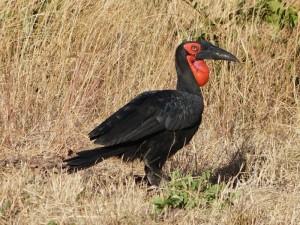 |
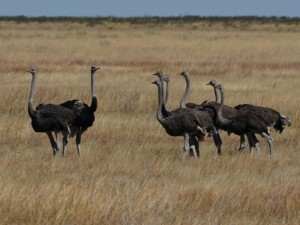 |
I was not hungry and used the free time looking at shops to have an idea about the standard of living here. After a cursory look, I find food and goods comparatively cheap and abundant. Then we proceeded to Gweta, a gateway to the massive Makadikgadi and Nxai Pans. By 2 pm, we reached Gweta Lodge run by an English family. The lodge is lovely and well-managed. I had a nice room with an outdoor shower.
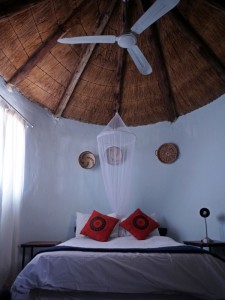 |
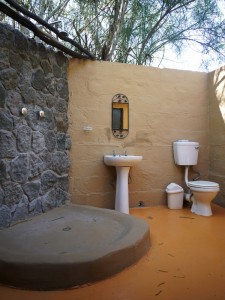 |
At 3pm, we set off another excursion to the Makadikgadi Pan for 850 pula. It is a long bumpy drive through an arid area. I was not really sure what we were looking for as the guide-driver said not a single word. In any case, we saw a couple of mongoose but failed to spot a meerkat (I thought I saw one but was not sure). Then the 4×4 vehicle stopped at the edge of the Pan where we watched sunset which was not spectacular. The salt pan is nothing compared with the one I have visited in Bolivia. It was windy and cold and we did not get back to the lodge till 7pm. I consider this excusion expensive and uninteresting owing to lack of interpretation and wildlife and unimpressive landscape. We had an excellent BBQ dinner tonight.
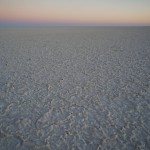 |
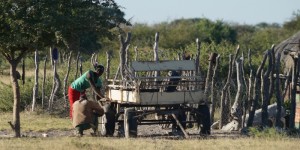 |
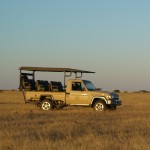 |
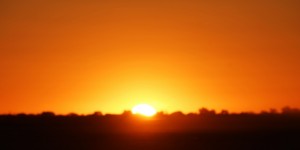 |
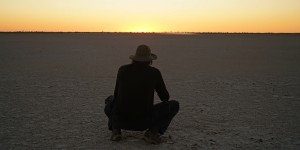 |
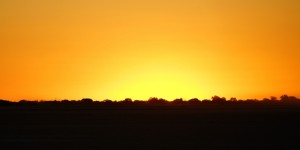 |
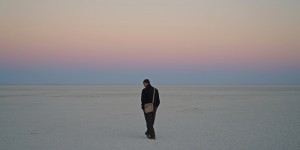 |
May 30 Monday: Gweta – Maun (250km)
We had a guided village walk before leaving around 10am. The village has a population of several thousands. There are two local schools each with over 600 students. The premise looks airy and tidy. We were taken to see a nursery class of 5-year-old who are taught to sing and speak in English. We also saw a group of women preparing lunch for the kids. A science teacher told us that the salary for teacher is about 1500 pula a month.
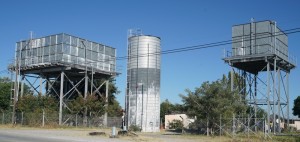 |
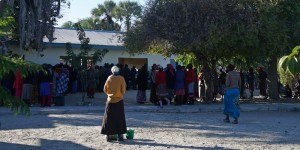 |
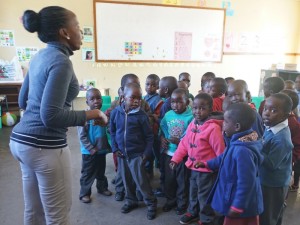 |
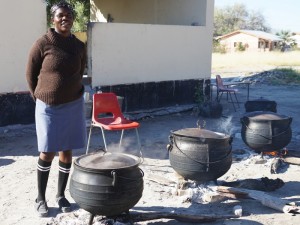 |
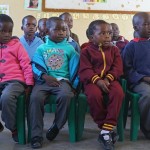 The Botswana government seems to doing something for the people. Education is free. People rendering services such as cleaning common areas, collecting garbage etc can get a pay from the government and the elderly people get a small sum a month. Foster parents for a parent-less child can get 650 pula a month. One can rent a basic traditional house without water or electricity for 50 pula a month.
The Botswana government seems to doing something for the people. Education is free. People rendering services such as cleaning common areas, collecting garbage etc can get a pay from the government and the elderly people get a small sum a month. Foster parents for a parent-less child can get 650 pula a month. One can rent a basic traditional house without water or electricity for 50 pula a month.
We stopped in Maun for lunch and shopping. I managed to find a replacement sun glass for 25pula in a local market. Then we settled in the Delta Rain‘s Sitatunga Safari Camp by the river for a leisure afternoon. I spent time in sorting out photos.
May 31 Tuesday: Maun – Okavango Delta (60km)
Okavango Delta is a very large inland delta and natural wetland spreading over 1.6million ha in northern Botswana. The Okavango River rises in Angola and flows south dividing repeatedly after crossing into Botswana to form an intricate floodplain of channels which spreads out into a broad flat inland delta. Chief’s Island formed by a fault line which uplifted an area over 70km long and 15km wide is the largest island in the delta. The Moremi Game Reserve, a national park located on the eastern side of the delta is famous for wildlife – elephant, crocodile, lion, zebra, leopard, hyena, springbok, kudu, lechwe antelop, impala, buffalo, rhino, warthog, baboon, African wild dog, birds, ll and birds. Given its scale and magnificence – the only one of its kind in the world, the Okavango Delta became the 1000th World Heritage Site on June 22 (my birthday), 2014. Five ethnic groups each with its own ethnic identity and language live in the Delta. They are Hambukushu, Dceriku, Wayeyi, Bugakhwe and llanikhwe. The first three groups have traditionally engaged in mixed economies of millet/sorghum agriculture; fishing hunting and the collection of wild plant foods and pastoralism.
After breakfast, we got on a truck with our overnight bag. After a bumpy ride on a dirt road for an hour and a half, we arrived at a landing point and were met by a group of Tswans polers. Each mokoro paddled by a poler carries two passengers. Andrea and I got into a mokoro with Anita, a tall and beautiful girl as our poler. We had a leisure ride through labyrinthine of channels bordered by tall grasses and papyrus for an hour and a half before reaching our camp site. We saw several fish eagles and a number of elephants and storks on the way. I had a tent with two camp beds and an attached shower and toilet. What a luxury!
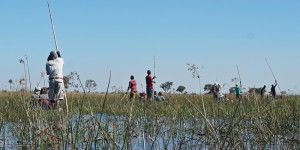 |
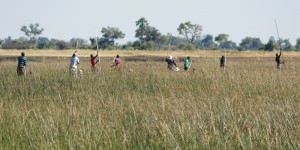 |
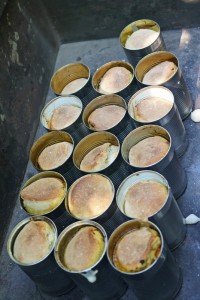 |
Our local guides prepared an excellent mince meat with baked bread in a tin container. At 3:30pm they took us on a two and a half hour walking safari. We saw elephants, zebras and lechwes and watched sunset on our way back to the camp site.
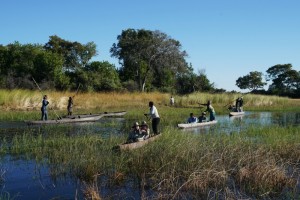 |
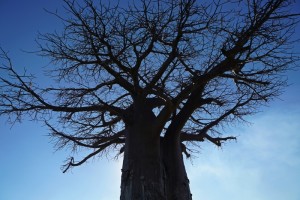 |
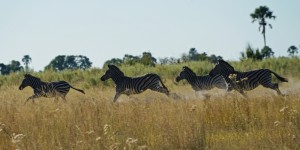 |
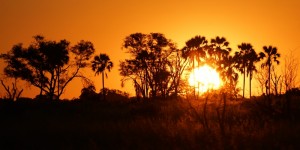 |
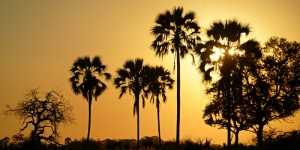 |
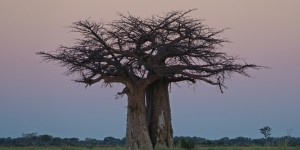 |
I took a refreshing cold shower before joining others to sit by the camp fire. We had a delicious dinner followed by star-gazing, singing and dancing by our polers and local guides.
June 1 Wednesday: Okavango Delta – Maun (60km)
We got up around 6am and joined a morning walk. We saw no animal but I was not disappointed. I enjoy the landscape and the ambiance. After having a nice brunch with freshly baked bread, we made our way back to the landing point.
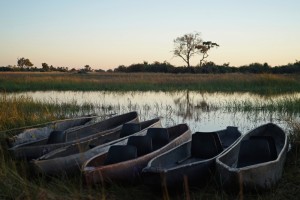 |
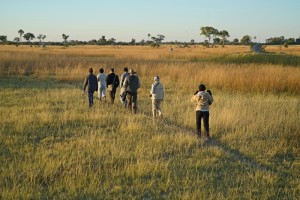 |
The water channel was very busy this morning: some 40-50 tourists were sitting in the mokoro trip heading to their campsite somewhere in the delta. Good business for the locals!
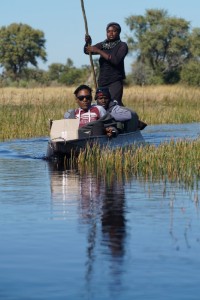 |
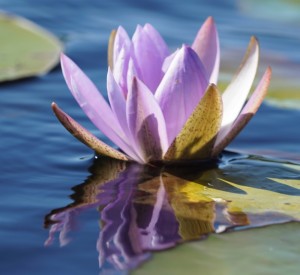 |
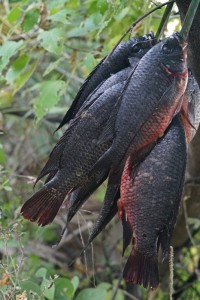 |
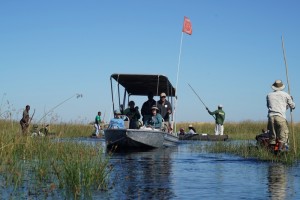 |
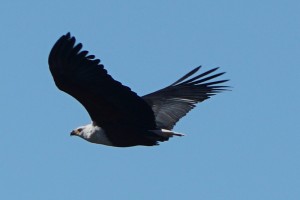 |
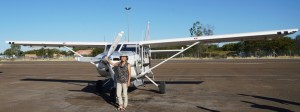 Our truck took us to Maun for shopping and lunch. I had street food (corn and beans with chili sauce) for 12 pula. We had a free afternoon in the Delta Rain’s Sitatunga Safari Camp. Dru and her daughter Becky who had lived in Botswana some thirty years ago were keen to take the helicopter flight which cost 1500pula per person. Andrea and I preferred a 45-minute flight for 950 pula. Finally Dru, Becky, Andrea, Simon and I took the scenic flight and had a great time.It’s the best scenic flight I have had in my life: the colours, the water channels, vegetation and viewing of wildlife from the air are awesome. I spotted elephants, lechwes, zebras, herds of buffaloes, hippos, birds, giraffe etc.
Our truck took us to Maun for shopping and lunch. I had street food (corn and beans with chili sauce) for 12 pula. We had a free afternoon in the Delta Rain’s Sitatunga Safari Camp. Dru and her daughter Becky who had lived in Botswana some thirty years ago were keen to take the helicopter flight which cost 1500pula per person. Andrea and I preferred a 45-minute flight for 950 pula. Finally Dru, Becky, Andrea, Simon and I took the scenic flight and had a great time.It’s the best scenic flight I have had in my life: the colours, the water channels, vegetation and viewing of wildlife from the air are awesome. I spotted elephants, lechwes, zebras, herds of buffaloes, hippos, birds, giraffe etc.
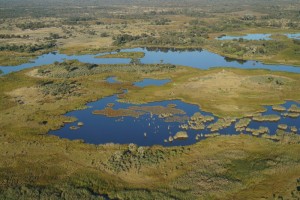 |
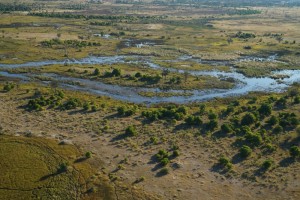 |
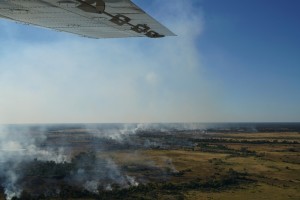 |
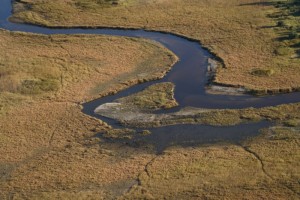 |
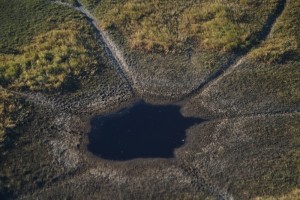 |
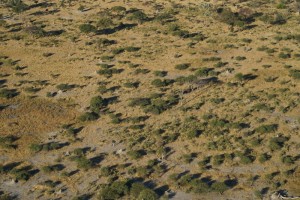 |
It was almost 6 pm when we got back to the camp. Tonight we had stewed ox-tail for dinner. It was so tender and delicious that I had two full plates!
June 2 Thursday: Maun – Serowe (next to the border) (530km)
We had the longest driving day today. We set off at 7:30am driving through the Kalahari desert region via Mopipi and could see vast salt pans in the distance. Around lunch time, we passed the road that goes to the diamond mines in Orapa. We had the shortest lunch break of the tour (30 minutes). Once again, I had street food (20 pula) instead of fast food from supermarket. But it was not as good as what I had in Maun.
The only activity today was a game drive in the Khama Rhino Sanctuary. We arrived around 2:30pm and two 4×4 vehicles took us around this sanctuary established in 1989 by a group of locals who wanted to convert the Serowe Pan into a conservation region for the rhino that inhabit the area. Starting with 4 white and 2 black rhinos, the sanctuary now boasts over 65 white and 7 black rhinos. Poaching is generally not a problem in Botswana owing to the government’s determination and successful deployment of its Defense Force.
During the 2-hour game drive. I saw six white rhinos, lots of wildebeests, zebras, elands and ostriches and one giraffe.
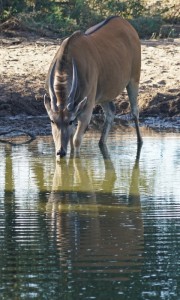 |
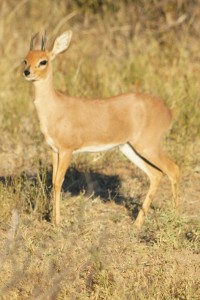 |
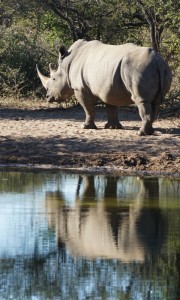 |
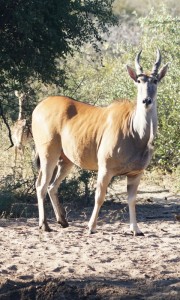 |
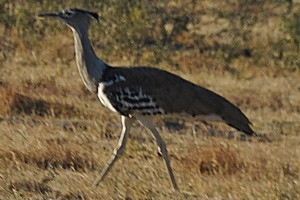 |
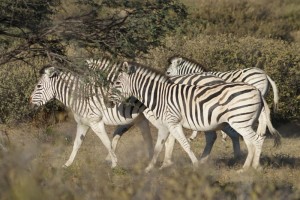 |
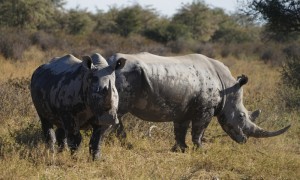 |
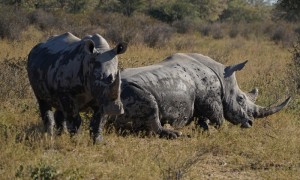 |
We left after 5pm and still had 150km to go. It got dark and Simon had to slow down. We were relieved when we finally arrived at the Camp Itumela next to the border at 7:30pm. I stayed in a tent-room with four beds and a large balcony facing a river. We had a nice BBQ dinner and an early night after a tiring long driving day.
June 3 Friday: Serowe, Botswana – Johannesburg, South Africa (about 450km)
We had a long journey to Johannesburg. Simon hoped to reach the ending point at Safari Club close to the airport around 2pm. We had no trouble in going through the Botswana border control. But I had a terrible encounter with a South African immigration officer who insisted that Hong Kong is part of China and I must have a visa. He did not take my words that a Hong Kong SAR passport holder does not need a visa for South Africa. As he was unreasonable, I said I could enter with my Portuguese passport. He then played another trick and insisted that I should get a stamp on my Portuguese passport from Botswana. He told me and Simon to return to Botswana to fix the stamp.
Simon and I walked back and a nice Botswana officer gave us a lift. Of course the Botswana border staff would not give another stamp on my Portuguese passport (they had already stamped on my HKSAR passport). We returned to the South African side and tried to take up the matter again with the officer. I reiterated that HKSAR passport requires no visa for South Africa. Simon was getting nervous as the group had to reach Johannesburg without further delay. After speaking to someone, he returned and asked me how much rand I had. I said R200. He took my note and put it in his folder together with my passport. Then someone stamped my HKSAR passport with a 30-day stay chop. It was about 9:30am when we left the border. It is the first time I have ever had such experience. I am sorry for South Africa which is the leading country in Africa.
Traffic accidents are common in South Africa. Today, we had delays on the road and did not arrive at the Safari Club around 3pm. We hurriedly said good-bye to Judy and family before Simon took them off to the airport to catch their flight to Cape Town. Others waited for taxi which took them to their hotels. I went nowhere as I would spend a night there and take a free ride to the airport at 6:30am the following day for my flight to Mauritius after spending 33 full days in Southern Africa.
Remarks (to add)


